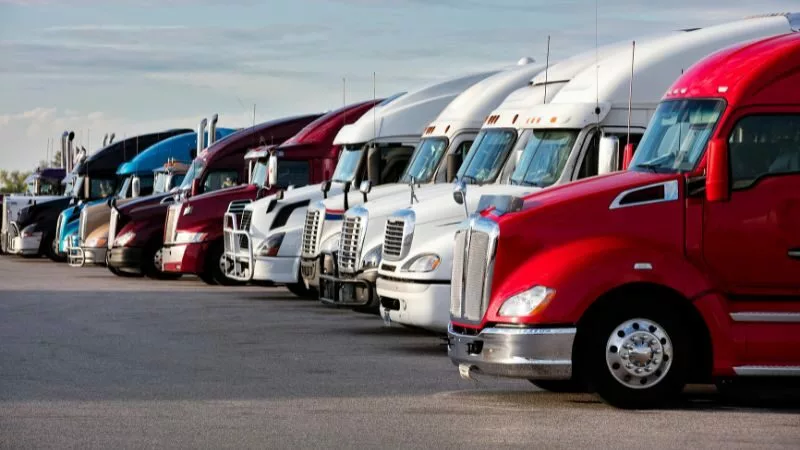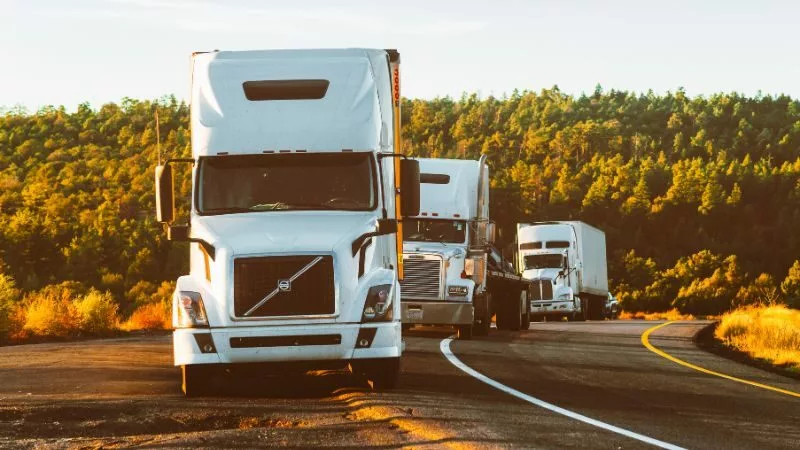For anyone in need of logistics solutions, faster or more efficient freight choices like air or sea are often the first to come to mind. While they are also great solutions, road freight transportation services remain the backbone of regional and national supply chains. When a shipment needs to move directly from a dock door to a storefront or job site, trucks deliver the reach and timing others can’t.
In this article, we will present to you what you need to know about road freight, and why you should adopt road freight transport services in China.
Service Models and Equipment for Road Freight Transport
In the core of road freight lie three major service models. Paired with different operational methods and trucking equipment, they provide versatile and seamless solutions for nearly any industry.

Full Truckload (FTL), Less-Than-Truckload (LTL), and Partial
Full Truckload (FTL) is used when your shipment is large enough to fill an entire trailer, typically over 15 pallets or when you require the trailer’s full space. The primary advantage is direct transit from origin to destination with no intermediate stops for other cargo. This results in the fastest possible road transit time, significantly fewer handlings (which drastically reduces the risk of damage or loss), and dedicated use of the trailer, which is crucial for sensitive, high-value, or temperature-controlled goods.
From a cost perspective, FTL is priced for the entire trailer, not the weight, making it the most efficient and secure choice for high-volume lanes, time-critical deliveries, or shipments that require specialized equipment.
Less Than Truckload (LTL) is the consolidation model, where your palletized shipment shares trailer space with freight from other businesses. The freight moves through a network of terminals, where it is sorted and transferred between trucks to reach its final destination.
Pricing is complex and is calculated based on the freight’s weight, dimensions, density, and its assigned “freight class”—a standardized classification based on product value, liability, and handling difficulty. While LTL is highly cost-effective for smaller shipments (typically 1-6 pallets), the trade-off is longer transit times due to terminal handling and a higher inherent risk of damage from multiple load/unload cycles. It is ideal for non-urgent, palletized freight that doesn’t justify the cost of an entire trailer.
Partial Truckload (PTL) occupies the strategic middle ground, designed for mid-sized shipments that are too large for cost-effective LTL (e.g., 7-14 pallets) but don’t require a full trailer. In a PTL move, your freight is grouped with a few other shipments heading in the same general direction, but it bypasses the extensive terminal network of the LTL system. This means your goods are handled far less frequently, often traveling on a more direct route.
You benefit from a cost that is lower than a full truckload and often becomes more competitive than LTL for denser, heavier mid-sized shipments, while also enjoying better speed and safety than the standard LTL option.
Other Operation Methods
Besides the three core service models, there are also other operation methods that frequently appear in road freight logistics.
- Dedicated Fleets: Trucks and drivers committed to a single company’s network. Results in predictable capacity, consistent service levels, and alignment with operational rhythms.
- Milk Runs: Scheduled routes that collect from or deliver to multiple stops within a region, aimed at consolidating volume and reducing empty miles.
- Cross-Docking: Direct transfer of goods between inbound and outbound trucks with minimal storage. Minimizes dwell, shrinks inventory on hand, and accelerates flow.
Road Freight Equipment
The freight trucks, along with their attached trailers, are the very basics of road freight logistics solutions. They come in many types and forms:
- Dry Van: Enclosed trailers for general merchandise, packaged foods, and consumer products.
- Reefer: Temperature-controlled units for perishables, pharmaceuticals, and other goods requiring precise set points and continuous monitoring.
- Flatbed: Open-deck trailers for oversized or irregular loads such as steel coils, lumber, or heavy equipment. They often require tarping and securement expertise.
- Specialized: Includes step-decks, double-drops, tankers, and equipment for hazardous or over-dimensional freight.

Road Versus Rail, Air, and Ocean
- Road: Best for short-to-medium distances, time-sensitive delivery, and door access. Vulnerable to traffic, weather, and local regulations.
- Rail: Efficient for bulk and long-haul corridors, but typically requires drayage on both ends.
- Air: Fastest for urgent, high-value cargo. Its costs are significantly higher and capacity is limited.
- Ocean: Most economical for large volumes globally, but is dependent on port and drayage operations.
Most modern supply chains mix modes. Road often bookends the journey, and even intermodal and air depend on trucks for the first and last mile.
Cost Drivers of Road Freight Transportation
Base Rates, Fuel Surcharges, and Accessorials
Road freight costs typically include a basic rate plus a fuel surcharge indexed to fuel prices. Beyond that, accessorial charges account for service specifics the standard rate doesn’t cover. Common accessorials include:
- Location Challenges: Liftgate (for a truck without a dock), residential area, or inside delivery.
- Timing & Scheduling: Appointment fees, after-hours service, or redelivery after a failed attempt.
- Waiting & Delays: Charging for the driver’s time if loading/unloading takes too long.
- Cancellation Fee (TONU): Paying for the truck that was booked but not used.
- Unloading Help: Paying for a helper (lumper) to unload the goods.
Weight, Density, and Freight Class for LTL
LTL pricing hinges on weight, density, and commodity classification. Denser freight that consumes less cube typically prices more favorably. Accurate dimensions, stackability, and correct freight class reduce reweighs, reclassifications, and disputes. Palletizing, shrink-wrapping, and using corner boards can improve density and reduce handling risk, often lowering total landed cost.
Spot, Contract and Seasonal Volatility
Spot rates track real-time market capacity. When demand spikes, produce season, major holidays, construction peaks, spot pricing climbs and tender acceptance falls. Contracts stabilize budgets and service levels over time but may sit above spot in soft markets. Many shippers blend the two: anchor core lanes under contract, then use the spot market or mini-bids for overflow and event-driven surges.

Advantages of China Land Transport
Extensive Network Coverage and Superior Connectivity
China boasts one of the world’s most extensive road networks, featuring a continuously expanding system of expressways and national highways. Near the end of 2025, China had built a whopping 190 thousand kilometers of highway spanning over 9.6 million square kilometers of landmass, and this number doesn’t even account for the city and rural road networks.
This extensive infrastructure ensures transport services can reach every corner of the country, from bustling coastal metropolises and industrial towns to inland cities and remote villages. For goods needing direct movement from a factory gate to a port, an air hub, or a road transport nexus, road transport provides an unmatched “last-mile” and “door-to-door” service capability that other modes cannot replicate.
Significant Cost-Effectiveness and Operational Flexibility
Despite the initial costs for the industry research and investment, the robust EV industry in China managed to overcome the obstacles for green and cost-efficient road transport, and the freight industry in China caught up with the trend of EVs. As a result, the total number of operating freight EV in China increased from 58000 units in 2020 to 457000 units in 2024, with an annual compound growth rate exceeding 60%. Chinese government also played an important role in pushing for New Energy Vehicle (NEV) adoption through subsidies, road-toll reductions, preferential urban access for electric trucks, and charging infrastructure development.
China road logistics services are also being optimized by AI. Companies are leveraging AI and the Internet of Things (IoT) to move from simple data visualization to automated decision-making. This helps optimize everything from route planning to fleet management and driver safety monitoring. Shippers now can flexibly tailor pickup windows and precise delivery appointments based on production schedules or sales cycles, a level of agility that rail and air transport, bound by fixed schedules, find difficult to match.
Competitive Edge with Our Road Freight Services
Founded by experienced freight forwarders, Luckystar Logistics has provided trusted and competitive shipping services across the globe. With transparent pricing and proactive communication, we provide tailored logistics programs, streamline your supply chain, and ensure compliance and smooth operation. From warehousing to customs clearance, our mission is to turn your transportation into a verifiable competitive advantage.
Ready to experience the Luckystar difference? Contact us today and let us demonstrate our commitment to excellence!
Frequently Asked Questions
How do shippers keep my cargo safe during transit?
This includes rigorous driver background checks, the use of GPS-tracked trailers with geofencing capabilities, and tamper-evident seals that are logged upon application and removal. For high-value goods, you can often request enhanced security protocols, such as dedicated (non-stop) services or two-driver teams to minimize unattended stops.
How are cargo damage or loss claims typically handled?
Upon delivery, any visible damage or shortage should be noted on the Proof of Delivery (POD) document. To file a claim, you must notify the carrier within a specified timeframe (e.g., 24-48 hours for concealed damage) and provide supporting documentation, including photos, the original bill of lading, and the POD. Look for carriers with a straightforward, documented claims process and a high settlement rate to ensure a smooth resolution.
What packaging and palletization standards are best for preventing damage?
Proper packaging is critical for LTL shipments, as they are handled multiple times. We strongly recommend:
- Using sturdy, GMA-style pallets that can withstand stacking.
- Employing stretch wrap securely to unitize the load and prevent shifting.
- Using edge protectors and slip sheets to protect cartons from straps and compression.
- Avoiding overhang, which is a common cause of damage.
- Clearly labeling all sides of the shipment with the bill of lading number and handling instructions.
What specific documentation or preparation is required for shipping hazardous materials via road freight in China?
Shipping hazardous materials (hazmat) requires strict adherence to regulations. Beyond the standard bill of lading, you will need to provide a properly completed Safety Data Sheet (SDS) and ensure all packaging is UN-certified and clearly marked with the correct hazard labels and placards. The shipper is responsible for accurately declaring the materials and ensuring the driver has all necessary transport documents and emergency information in the cab. Working with a carrier certified and experienced in hazmat transport is essential.
